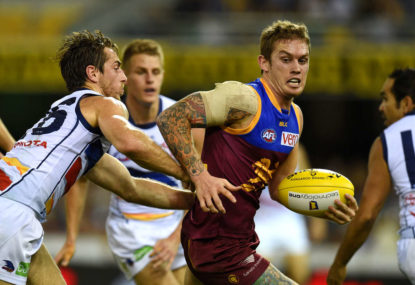Intensity. It’s one of the most important aspects of football, but the most overlooked.
We hear about gameplans ad nauseum, along with offensive systems and defensive structures, yet they all become meaningless if the appropriate intensity isn’t delivered.
In the opening game of the season, Carlton delivered AFL-standard intensity while their opponent Richmond didn’t. It allowed the Blues to play above their station, holding the lead for long periods of the game, but ultimately they lacked the overall polish to convert their advantage to a winning one.
Richmond has been a top-six side over the last three seasons while Carlton has resided in the bottom four. When the lower side brings intensity and the better side doesn’t, upsets can happen.
The Tigers will be the superior team in 2016, but the Blues were the better side on the night.
Melbourne showed fanatical intensity in the first quarter and a half of their win over Greater Western Sydney, but struggled to convert it to the scoreboard. When they dropped away, so did their hold on the game, and a ten-point lead became a 22-point deficit as the more talented Giants were able to get their running game going.
The Demons came out firing in the last quarter, full of intensity, GWS came out with barely a whimper, and that was the ball game. Intensity got Melbourne an early lead, a lack of it cost them it, and by delivering it again, they put themselves in a position to get the win.
Gold Coast were able to walk their way to a ten-goal win free of exertion, because Essendon failed to bring appropriate intensity, one of only four sides not to do so over the opening round. We know the Dons are going to have a talent problem all season, but their lack of application from the opening bounce was inexcusable, particularly against a side they should have considered themselves some chance against.
North Melbourne and Adelaide were two evenly matched sides that equalled each other for intensity. Within those parameters, the Crows played the better football for the majority of the game, but they didn’t have an answer to Brett Harvey and Todd Goldstein in the crucial moments.
Intensity can keep you in a game for long periods, but sometimes you need the class to win it for you.
Collingwood and Fremantle were the two most appalling cases of lack of intensity over the entire weekend, and it was no coincidence they suffered the two biggest losses of the round.
In fact, their lack of intensity was so abject and pathetic, that it’s hard to read too much into how Sydney and the Western Bulldogs played, impressive as they were.
AFL teams presenting themselves in that fashion, as the Pies and Dockers did, is simply unacceptable, and frankly they haven’t been damned enough for it. It was led from the top too, with Scott Pendlebury and Nat Fyfe, two of the games undisputed champions and my personal favourites, both playing flat, making an abnormal amount of skill errors and mistakes.
St Kilda has made themselves all about intensity in their time under Alan Richardson, and gave every other team in the competition a lesson in how to apply it against Port. They didn’t get the win, thanks to skill limitations and being one NAB Challenge game short, but they earned respect. The Power had to give their all for 100 per cent of the game, which they did, in order to shake them.
Brisbane lost by ten goals to West Coast in Perth, but wasn’t due to lack of intensity. They came out hard and desperate, had a crack in the contest and tried to play a bright brand of football.
The Lions were always going to be outclassed and outmatched, but at least went down swinging and kicked 15 goals along the way. If they had brought Collingwood or Fremantle intensity, the margin would have been 164 instead of 64.
Geelong and Hawthorn gave us a masterclass of intense, tough football on Easter Monday, as they have done for a decade now. The game ebbed and flowed, but the intensity from both sides stayed high.
Post-Round 1 discussions are now a race to see who can over-react the least, everyone attempting to engage in sober discussion as we all try and work out what was real and what wasn’t in the first week of footy for the year.
Collingwood and Fremantle will likely not play that badly again this year. It’s hard to see how they could. Sydney and the Bulldogs will have matches where they don’t turn up, and they will look a shadow of the sides we saw on the weekend.
So this week, and over the course of the season, we’ll hear lots of reasons why teams win or lose. Stats will be quoted about technical aspects of the game, and game styles will be analysed. Yet a lot of the time it will be about intensity.
There are always going to be differences in talent across AFL clubs. Differences in coaching excellence too. Differences in player leadership will also have an impact.
But playing with intensity must be a non-negotiable. The best teams will deliver it almost always, and those teams will end up becoming the best clubs over time.





























































































